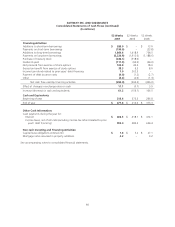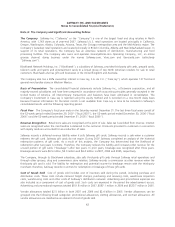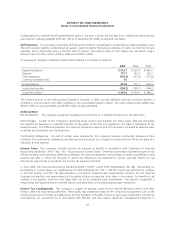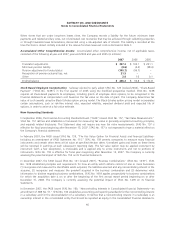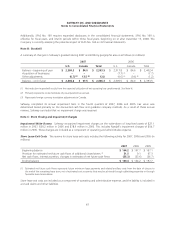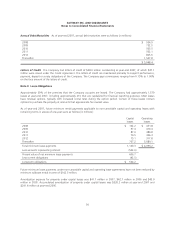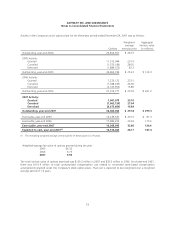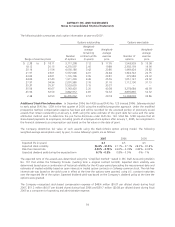Safeway 2007 Annual Report Download - page 68
Download and view the complete annual report
Please find page 68 of the 2007 Safeway annual report below. You can navigate through the pages in the report by either clicking on the pages listed below, or by using the keyword search tool below to find specific information within the annual report.
SAFEWAY INC. AND SUBSIDIARIES
Notes to Consolidated Financial Statements
When stores that are under long-term leases close, the Company records a liability for the future minimum lease
payments and related ancillary costs, net of estimated cost recoveries that may be achieved through subletting properties
or through favorable lease terminations, discounted using a risk-adjusted rate of interest. This liability is recorded at the
time the store is closed. Activity included in the reserve for store lease exit costs is disclosed in Note C.
Accumulated Other Comprehensive Income Accumulated other comprehensive income, net of applicable taxes,
consisted of the following at year-end 2007, year-end 2006 and year-end 2005 (in millions):
2007 2006 2005
Translation adjustments $ 367.2 $ 195.1 $ 201.1
Minimum pension liability (4.6) (4.6) (28.4)
Pension adjustment to funded status (140.7) (96.7) –
Recognition of pension actuarial loss, net 21.5 ––
Other 2.8 1.0 0.1
Ending balance $ 246.2 $ 94.8 $ 172.8
Stock-Based Employee Compensation Safeway elected to early adopt SFAS No. 123 (revised 2004), “Share-Based
Payment” (“SFAS No. 123R”), in the first quarter of 2005 using the modified prospective method. SFAS No. 123R
requires all share-based payments to employees, including grants of employee stock options, to be recognized in the
financial statements as compensation cost based on the fair value on the date of grant. The Company determines fair
value of such awards using the Black-Scholes option pricing model. The Black-Scholes option pricing model incorporates
certain assumptions, such as risk-free interest rate, expected volatility, expected dividend yield and expected life of
options, in order to arrive at a fair value estimate.
New Accounting Standards
In September 2006, the Financial Accounting Standards Board (“FASB”) issued SFAS No. 157, “Fair Value Measurement.”
SFAS No. 157 defines and establishes a framework for measuring fair value in generally accepted accounting principles,
and expands related disclosures. This Statement does not require any new fair value measurements. SFAS No. 157 is
effective for fiscal years beginning after November 15, 2007. SFAS No. 157 is not expected to have a material effect on
the Company’s financial statements.
In February 2007, the FASB issued SFAS No. 159, “The Fair Value Option for Financial Assets and Financial Liabilities–
Including an amendment of FASB Statement No. 115.” SFAS No. 159 permits companies to measure many financial
instruments and certain other items at fair value at specified election dates. Unrealized gains and losses on these items
will be reported in earnings at each subsequent reporting date. The fair value option may be applied instrument by
instrument (with a few exceptions), is irrevocable and is applied only to entire instruments and not to portions of
instruments. SFAS No. 159 is effective for fiscal years beginning after November 15, 2007. The Company is currently
assessing the potential impact of SFAS No. 159 on its financial statements.
In December 2007, the FASB issued SFAS No. 141 (revised 2007), “Business Combinations” (SFAS No. 141R”). SFAS
No. 141R established principles and requirements for how an entity which obtains control of one or more businesses
(1) recognizes and measures the identifiable assets acquired, the liabilities assumed and any noncontrolling interest in the
acquiree, (2) recognizes and measures the goodwill acquired in the business combination and (3) determines what
information to disclose regarding business combinations. SFAS No. 141R applies prospectively to business combinations
for which the acquisition date is on or after the beginning of the first annual report period beginning on or after
December 15, 2008. The Company is currently assessing the potential impact of SFAS No. 141R on its financial
statements.
In December 2007, the FASB issued SFAS No. 160, “Noncontrolling Interests in Consolidated Financial Statements—an
amendment of ARB No. 51.” SFAS No. 160 establishes accounting and reporting standards for the noncontrolling interest
in a subsidiary and for the deconsolidation of a subsidiary. It clarifies that a noncontrolling interest in a subsidiary is an
ownership interest in the consolidated entity that should be reported as equity in the consolidated financial statements.
46






